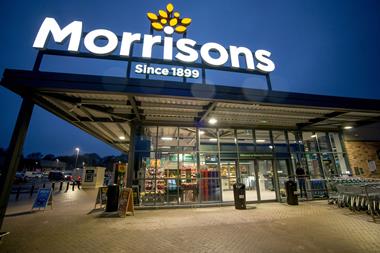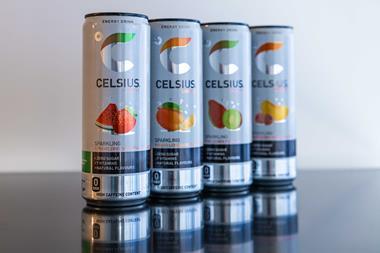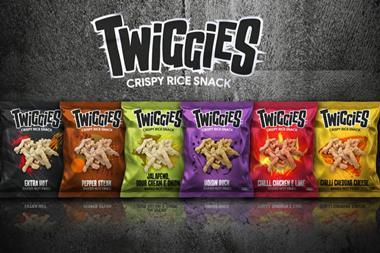70% of buyers believe the retail sector produces boring products, according to The Grocer’s reader survey. Stefan Chomka reports
Britvic’s announcement that it is launching a bottled water brand called Drench at a time when the food and drink industry is undergoing a drought in innovation is an irony that will not be lost on many in the industry.
These are sorry times for new product development if you are to believe retail buyers, the press (including The Grocer: ‘Where’s the wow factor?’ October 15, p30) or Andy Bond, who at the recent IGD annual convention accused the retail environment of “bland, amorphous sameness”.
In a reader survey conducted by The Grocer, 70% of buyers agreed with Bond that the retail sector is guilty of producing boring products, and only 30% believed suppliers were coming up with enough new ideas.
And while it is likely that Drench will prove a big hit for Britvic at a time of falling sales of carbonated soft drinks, the fact remains that the company’s biggest launch of 2006 will be a bottled form of one of the most abundant sources on earth.
Yet Britvic is by no means alone in erring on the side of caution with its NPD. Nestlé Rowntree’s Kit Kat extensions are seen as a prime offender. It is nearly always the first thing that springs to buyers’ minds when asked for an example of a ‘me too’ product that has gone one too far.
Tim Nicol, joint MD at innovation services company Make Innovation Happen, sympathises with retailers. “There are too many false innovations - old products masquerading as innovation,” he says. “About 82% of new product development is ‘me too’. There is a need to focus on bigger and better ideas.”
He adds, however, that this is not solely the fault of manufacturers and that retailers themselves must bear much of the blame. Poor innovation is symptomatic of retailers’ constant drive to push prices down, he says.
“All the retailers have defaulted on price, and price is a very big driver of this conservatism. The longer-term trend is that it has filtered down to the manufacturers. Looking at the markets, they have to fix the bottom line and cut budgets. Price is a brake on conventional innovation and we are now seeing the impact of the price war.”
Yvonne Taylor, business development director at product research and testing company, MSTS, says innovation comes in cycles and that these can also be linked with price. So while in some years there is a flurry of strong NPD, other years are dominated by cost reduction and product tweaking as companies fight to retain margins. “We are on a
downturn of innovation and an upturn of cost reduction at the moment,” says Taylor.
Retailers are also demanding quicker time to market for new products, yet require instant results, and this too has a detrimental effect on NPD, claims Nicol. In his IGD speech, Bond said it takes a new food or drink product between 24 and 26 weeks to hit the shelves, compared with four to six weeks “to design, source, make and distribute clothing globally”.
“If a product doesn’t hit target within weeks it is withdrawn,” says Nicol. “It is more risky as retailers want more immediacy. It drives safer and more samey innovation. Retailers have to be more patient with breakthrough products.”
Nicol suggests that some retailers are more farsighted than others, depending on how successful their core business is. “It is easier to be patient with innovation if you are already growing. Retailers are all under pressure and in a flat market they are looking for short-term gain.”
Manufacturers themselves cite higher retailer expectations, with decreasing patience, as barriers to the kind of NPD retailers are clamouring for. Fiona Vigar, marketing director at functional food company Provexis, says if retailers want true innovation, they have to wait for it.
In January, Provexis will launch Sirco, a fruit drink made with a patented tomato extract. The product, which it claims can help blood circulation and reduce heart attacks and strokes, was six years in the making. Provexis is also developing products with a broccoli extract that has health benefits, but they won’t be on the market until 2007.
Vigar rejects Bond’s assertion that clothing companies innovate at a faster pace. “Most high street fashion is not innovation. It’s copied from the catwalk. It’s more me toos.”
While the industry may be crying out for more innovation, if the consumer isn’t ready then even the most innovative products may never take off. “We know and work with highly innovative concepts that are new and exciting, but when they are put in front of the consumer they are not ready for them in sufficient numbers,” says Nicol.
Vigar voices a similar view. “I’ve seen products launched ahead of their time,” she says. “Our approach is to sit down with consumers and find out what they are interested in. In functional foods you can be way ahead of consumers. You want to be at the head of the curve but not so much so that consumers think you’re a freak product.”
Indeed, ventures such as Nestlé’s self-heating Nescafé drink and Unilever’s Rocket and Leaping Salmon meal kit may just have been ahead of their time.
To avoid such risk, MSTS’s Taylor advises that companies speak to consumers at the concept stage, something that many are still loath to do. “We say to our clients to build consumers into research and development much earlier on rather than rely on three marketers round a table who may not even be the target consumer.”
Yet at the same time, retailers have to take a more responsible approach to help drive innovation, rather than just demanding new products and then launching cheaper own label variants if they are a success. As Nicol says: “If you are the first to market you have all the costs of R&D. To then see it being copied at a cheaper price is galling.”
It’s not all doom and gloom. Products such as St Ivel Advance, Cravendale Hint Of, Vie Shot, Heinz Mean Beanz and Nescafé Half Caff are recent introductions that have all caught Taylor’s eye.
Hardware/software collaborations, such as Kenco’s link-up with Braun for the Tassimo coffee machine and Douwe Egberts’ tie in with Philips for Senseo, are other good NPD examples, adds Nicol.
So what about the future? Taylor believes most innovation will be in the functional food arena. But she is sceptical that next year will see much more innovation.
Nicol is more optimistic. “We are going to see some big things,” he says.
Only time will tell whether 2005 proves to be the year that innovation finally dried up - or when retailers and manufacturers alike realised that something had to change.
Britvic’s announcement that it is launching a bottled water brand called Drench at a time when the food and drink industry is undergoing a drought in innovation is an irony that will not be lost on many in the industry.
These are sorry times for new product development if you are to believe retail buyers, the press (including The Grocer: ‘Where’s the wow factor?’ October 15, p30) or Andy Bond, who at the recent IGD annual convention accused the retail environment of “bland, amorphous sameness”.
In a reader survey conducted by The Grocer, 70% of buyers agreed with Bond that the retail sector is guilty of producing boring products, and only 30% believed suppliers were coming up with enough new ideas.
And while it is likely that Drench will prove a big hit for Britvic at a time of falling sales of carbonated soft drinks, the fact remains that the company’s biggest launch of 2006 will be a bottled form of one of the most abundant sources on earth.
Yet Britvic is by no means alone in erring on the side of caution with its NPD. Nestlé Rowntree’s Kit Kat extensions are seen as a prime offender. It is nearly always the first thing that springs to buyers’ minds when asked for an example of a ‘me too’ product that has gone one too far.
Tim Nicol, joint MD at innovation services company Make Innovation Happen, sympathises with retailers. “There are too many false innovations - old products masquerading as innovation,” he says. “About 82% of new product development is ‘me too’. There is a need to focus on bigger and better ideas.”
He adds, however, that this is not solely the fault of manufacturers and that retailers themselves must bear much of the blame. Poor innovation is symptomatic of retailers’ constant drive to push prices down, he says.
“All the retailers have defaulted on price, and price is a very big driver of this conservatism. The longer-term trend is that it has filtered down to the manufacturers. Looking at the markets, they have to fix the bottom line and cut budgets. Price is a brake on conventional innovation and we are now seeing the impact of the price war.”
Yvonne Taylor, business development director at product research and testing company, MSTS, says innovation comes in cycles and that these can also be linked with price. So while in some years there is a flurry of strong NPD, other years are dominated by cost reduction and product tweaking as companies fight to retain margins. “We are on a
downturn of innovation and an upturn of cost reduction at the moment,” says Taylor.
Retailers are also demanding quicker time to market for new products, yet require instant results, and this too has a detrimental effect on NPD, claims Nicol. In his IGD speech, Bond said it takes a new food or drink product between 24 and 26 weeks to hit the shelves, compared with four to six weeks “to design, source, make and distribute clothing globally”.
“If a product doesn’t hit target within weeks it is withdrawn,” says Nicol. “It is more risky as retailers want more immediacy. It drives safer and more samey innovation. Retailers have to be more patient with breakthrough products.”
Nicol suggests that some retailers are more farsighted than others, depending on how successful their core business is. “It is easier to be patient with innovation if you are already growing. Retailers are all under pressure and in a flat market they are looking for short-term gain.”
Manufacturers themselves cite higher retailer expectations, with decreasing patience, as barriers to the kind of NPD retailers are clamouring for. Fiona Vigar, marketing director at functional food company Provexis, says if retailers want true innovation, they have to wait for it.
In January, Provexis will launch Sirco, a fruit drink made with a patented tomato extract. The product, which it claims can help blood circulation and reduce heart attacks and strokes, was six years in the making. Provexis is also developing products with a broccoli extract that has health benefits, but they won’t be on the market until 2007.
Vigar rejects Bond’s assertion that clothing companies innovate at a faster pace. “Most high street fashion is not innovation. It’s copied from the catwalk. It’s more me toos.”
While the industry may be crying out for more innovation, if the consumer isn’t ready then even the most innovative products may never take off. “We know and work with highly innovative concepts that are new and exciting, but when they are put in front of the consumer they are not ready for them in sufficient numbers,” says Nicol.
Vigar voices a similar view. “I’ve seen products launched ahead of their time,” she says. “Our approach is to sit down with consumers and find out what they are interested in. In functional foods you can be way ahead of consumers. You want to be at the head of the curve but not so much so that consumers think you’re a freak product.”
Indeed, ventures such as Nestlé’s self-heating Nescafé drink and Unilever’s Rocket and Leaping Salmon meal kit may just have been ahead of their time.
To avoid such risk, MSTS’s Taylor advises that companies speak to consumers at the concept stage, something that many are still loath to do. “We say to our clients to build consumers into research and development much earlier on rather than rely on three marketers round a table who may not even be the target consumer.”
Yet at the same time, retailers have to take a more responsible approach to help drive innovation, rather than just demanding new products and then launching cheaper own label variants if they are a success. As Nicol says: “If you are the first to market you have all the costs of R&D. To then see it being copied at a cheaper price is galling.”
It’s not all doom and gloom. Products such as St Ivel Advance, Cravendale Hint Of, Vie Shot, Heinz Mean Beanz and Nescafé Half Caff are recent introductions that have all caught Taylor’s eye.
Hardware/software collaborations, such as Kenco’s link-up with Braun for the Tassimo coffee machine and Douwe Egberts’ tie in with Philips for Senseo, are other good NPD examples, adds Nicol.
So what about the future? Taylor believes most innovation will be in the functional food arena. But she is sceptical that next year will see much more innovation.
Nicol is more optimistic. “We are going to see some big things,” he says.
Only time will tell whether 2005 proves to be the year that innovation finally dried up - or when retailers and manufacturers alike realised that something had to change.













No comments yet